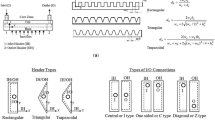Abstract
Thermal management is an integral part of micro-heater design. In this paper, the application of a microcavity concept is introduced. The thermal behavior of the proposed novel structure is also numerically investigated in this research to indicate its capability to improve the micro-heaters efficiency and eliminate the common problems of membrane-type heaters. The numerical simulation of the heater structure shows that by using this approach, not only a considerable decrease in power consumption of micro-heaters is attained but also the bubble nucleation point in micro-pumps/micro-injectors can exactly be controlled. As a result, the lengthening of rectangular micro-cavities can contribute to improving heater operation to a greater extent than thickening them. Having a more simple manufacturing process, micro-heater yet has very similar thermal operation characteristics in comparison with bonded heaters.















Similar content being viewed by others
References
Bhattacharya P, Sen S, Chaterjee A, Saha H (2005) Design of the optimum microheater for smart MEMS gas sensor. Int Conference on smart materials structure and systems, Bangalore, India, 28–30 July
Cengel A (2003) Heat transfer—a practical approach, 2nd edn. McGraw-Hill, New York
Han J, Kadowaki T, Sato K, Shikida M (1999) Thermal analysis of fingerprint sensor having a microheater array. Int symposium on micromechatronic and human science, IEEE
Jun TK, Kim CJ (1996) Microscale pumping with traversing bubbles in microchannels. Technical Digest. Solid-state sensor and actuator workshop, Transducer, pp 144–147. Cleveland 180 Heights, OH
Li ZX, Wang MR, Tan LY (2002) Experimental investigation on phase transformation type micropump. Chin Sci Bull 47:518–522
Li H, Elias E, Mujumdar AS (2005) Theoretical simulation of explosive boiling. Int Commun Heat Mass Transf 32:612–619
Maxwell RB, Gerhardt AL, Toner M, Gray ML, Schmidt MA (2003) A microbubble-powered bioparticle actuator. J Microelectromechan Syst 12(5):630–640
Puigcorbe J, Vogel D, Michel B, Vila A, Gracia I, Cane C, Morante JR (2003) Thermal and mechanical analysis of micromachined gas sensors. J Micromechan Microeng 13:548–556
Singh I, Mohan S (2005) 3D simulation and electrothermal analysis of micro-hotplate design using CoventorWare for gas sensor applications. Int Conference on smart materials structure and systems, Bangalore, India, 28–30 July
Shoji M (2004) Studies of boiling chaos: review. Int J Heat Mass Transf 47:1105–1128
Tsai JH, Lin L (2002) Transient thermal bubble formation on polysilicon Miro-resister. J Heat Transf (Transaction of ASME), 124
Van Stralen SJD, Cole R (1979) Boiling phenomena, vol 1. McGraw-Hill, New York
Wang MR, Li ZX, Chen ZJ (2002) The pumping effect of traveling phase transition in microtubes. Int J Nonlinear Sci Numer Simul 3:565–568
Author information
Authors and Affiliations
Corresponding author
Rights and permissions
About this article
Cite this article
Kahroba, P., Mirzaee, I., Sharifi, P. et al. The microcavity-based micro-heater: an optimum design for micro-heaters. Microsyst Technol 14, 705–710 (2008). https://doi.org/10.1007/s00542-007-0418-x
Received:
Accepted:
Published:
Issue Date:
DOI: https://doi.org/10.1007/s00542-007-0418-x




